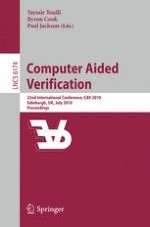2010 | Book
Computer Aided Verification
22nd International Conference, CAV 2010, Edinburgh, UK, July 15-19, 2010. Proceedings
Editors: Tayssir Touili, Byron Cook, Paul Jackson
Publisher: Springer Berlin Heidelberg
Book Series : Lecture Notes in Computer Science
